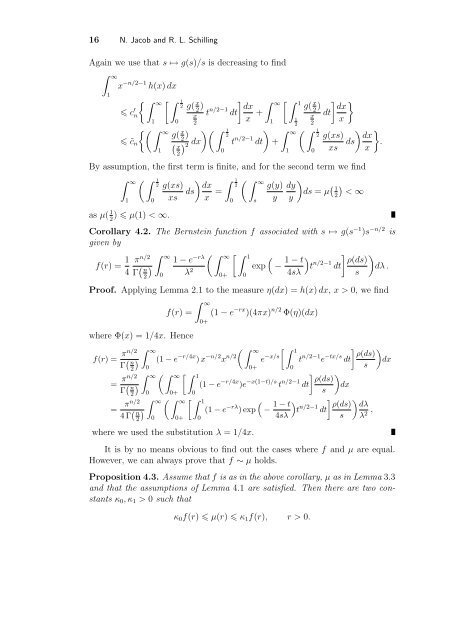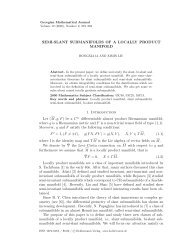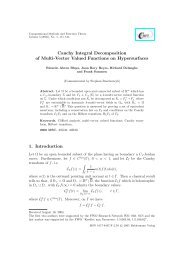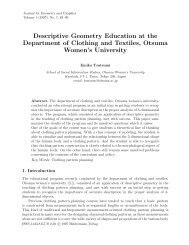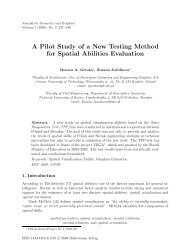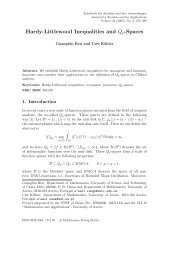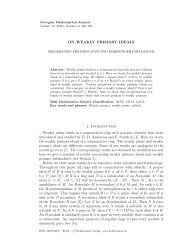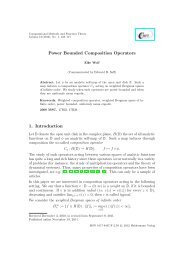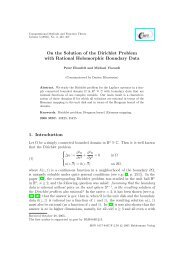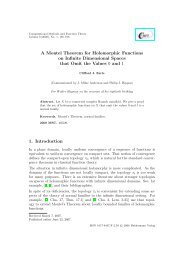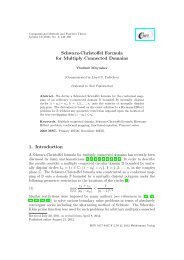Function Spaces as Dirichlet Spaces (About a Paper by Maz'ya and ...
Function Spaces as Dirichlet Spaces (About a Paper by Maz'ya and ...
Function Spaces as Dirichlet Spaces (About a Paper by Maz'ya and ...
You also want an ePaper? Increase the reach of your titles
YUMPU automatically turns print PDFs into web optimized ePapers that Google loves.
16 N. Jacob <strong>and</strong> R. L. Schilling<br />
Again we use that s ↦→ g(s)/s is decre<strong>as</strong>ing to find<br />
∫ ∞<br />
1<br />
x −n/2−1 h(x) dx<br />
c ′ n<br />
{ ∫ ∞<br />
1<br />
1<br />
[ ∫ 1<br />
2<br />
0<br />
g( x 2 )<br />
x<br />
2<br />
] ∫ dx ∞<br />
[ ∫ 1<br />
t n/2−1 dt<br />
x +<br />
{( ∫ ∞<br />
g( x<br />
˜c ) )( ∫ 1 )<br />
2<br />
2<br />
n ( x 2<br />
dx t<br />
2) n/2−1 dt +<br />
0<br />
1<br />
1<br />
2<br />
∫ ∞<br />
1<br />
g( x 2 )<br />
x<br />
2<br />
( ∫ 1<br />
2<br />
0<br />
] } dx<br />
dt<br />
x<br />
g(xs)<br />
xs<br />
ds ) dx<br />
x<br />
}<br />
.<br />
By <strong>as</strong>sumption, the first term is finite, <strong>and</strong> for the second term we find<br />
∫ ∞<br />
( ∫ 1<br />
( ∫<br />
2<br />
∞<br />
1<br />
<strong>as</strong> µ( 1 ) µ(1) < ∞.<br />
2<br />
0<br />
) ∫ 1<br />
g(xs) dx<br />
xs ds x = 2<br />
0<br />
s<br />
g(y)<br />
y<br />
dy<br />
y<br />
)<br />
ds = µ ( 1<br />
2)<br />
< ∞<br />
Corollary 4.2. The Bernstein function f <strong>as</strong>sociated with s ↦→ g(s −1 )s −n/2 is<br />
given <strong>by</strong><br />
f(r) = 1 π n/2 ∫ ∞<br />
(<br />
4 Γ ( 1 − e<br />
)<br />
−rλ ∫ ∞<br />
[ ∫ 1 (<br />
exp − 1 − t ) ] ) ρ(ds)<br />
t n/2−1 dt dλ .<br />
n<br />
2 0 λ 2 0+ 0 4sλ<br />
s<br />
Proof. Applying Lemma 2.1 to the me<strong>as</strong>ure η(dx) = h(x) dx, x > 0, we find<br />
f(r) =<br />
∫ ∞<br />
0+<br />
(1 − e −rx )(4πx) n/2 Φ(η)(dx)<br />
where Φ(x) = 1/4x. Hence<br />
∫ ∞<br />
( ∫ ∞<br />
[ ∫ 1<br />
] )<br />
f(r) = πn/2<br />
ρ(ds)<br />
Γ ( )<br />
n<br />
(1 − e −r/4x ) x −n/2 x n/2 e −x/s t n/2−1 e −tx/s dt dx<br />
2 0<br />
0+<br />
0<br />
s<br />
∫ ∞<br />
( ∫ ∞<br />
[ ∫ 1<br />
] )<br />
= πn/2<br />
ρ(ds)<br />
Γ ( )<br />
n<br />
(1 − e −r/4x )e −x(1−t)/s t n/2−1 dt dx<br />
2 0 0+ 0<br />
s<br />
∫ ∞<br />
( ∫ ∞<br />
[ ∫ 1<br />
= πn/2<br />
(<br />
4 Γ ( )<br />
n<br />
(1 − e −rλ ) exp − 1 − t ) ] ) ρ(ds) dλ<br />
t n/2−1 dt<br />
2 0 0+ 0<br />
4sλ<br />
s λ 2 ,<br />
where we used the substitution λ = 1/4x.<br />
It is <strong>by</strong> no means obvious to find out the c<strong>as</strong>es where f <strong>and</strong> µ are equal.<br />
However, we can always prove that f ∼ µ holds.<br />
Proposition 4.3. Assume that f is <strong>as</strong> in the above corollary, µ <strong>as</strong> in Lemma 3.3<br />
<strong>and</strong> that the <strong>as</strong>sumptions of Lemma 4.1 are satisfied. Then there are two constants<br />
κ 0 , κ 1 > 0 such that<br />
κ 0 f(r) µ(r) κ 1 f(r), r > 0.


